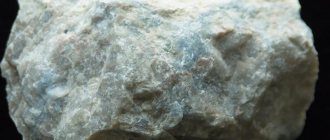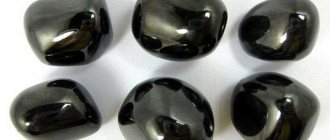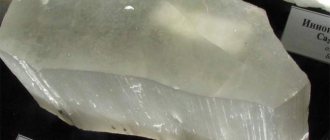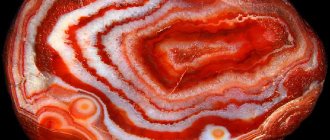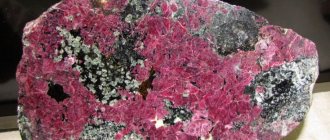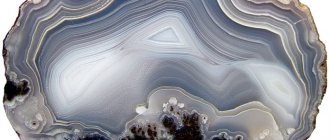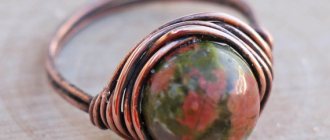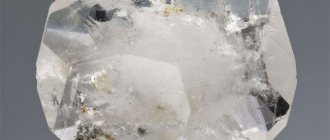| Category | Silicate minerals |
| Title in English | Biotite |
| Formula | K (Mg, Fe)3[Si3AlO10] [OH, F]2 |
| Group | Mica group |
| Color | Black, Brown |
| Stroke color | White, Gray |
| Shine | Glass |
| Transparency | Transparent, Translucent, Opaque |
| singonia | Monoclinic |
| Hardness | 2 — 3 |
| Cleavage | Very perfect by {001} |
| Density, g/cm³ | 2,8 — 3,4 |
| Kink | The mineral is elastic, flexible, splits into leaves |
| origin of name | The stone is named in memory of the famous French physicist Jean-Baptiste Biot. By the way, he was awarded the Rumford Medal - this award is awarded by the Royal Society of London for important research in the field of physics. |
| Morphology | Biotite is characterized by the presence of clusters of flakes, prismatic crystals, tablets, as well as elongated and isometric plates. |
One of the natural minerals of the mica group is called biotite, and is also known as odenite and iron mica. Thin plates of this stone are transparent, they can even be translucent, and large crystals have a pronounced glass luster, but lack transparency. The main constituent elements of biotite are compounds of potassium, iron and magnesium, the percentage of which depends on the specific deposit of the sample. The mineral is characterized by the presence of many impurities, among which compounds of fluorine, sodium, lithium, barium, manganese, cesium, titanium and strontium are found.
Biotite deposits
Natural biotite consists of lamellar, scaly and columnar crystals that occur in rocks of igneous and metamorphic origin, as well as in basalt and quite often in pegmatite veins.
Biotite deposits are often adjacent to minerals such as feldspars, garnets, muscovites and andalusites. — Advertising —
Large amounts of biotite are being mined in countries such as Italy, Russia, Scandinavia, Brazil, Greenland and Alaska. Large crystals, made in the form of flat sheets, were discovered in southern Norway. Their sizes sometimes reach several square meters. High-quality jewelry specimens are found in German, Canadian and Tanzanian deposits.
Origin and places of extraction
Biotite, which is often called brown or black mica, began to be studied back in the 19th century. The properties of the material were then studied by the French military specialist, academician, physicist and mathematician Jean-Baptiste Biot. The breed received its name in his honor. The name was assigned to the stone by mineralogist Johann Hausmann in 1847. He decided to study the mineral in detail, identifying a whole group of substances. The properties of biotite were studied in the 20th century, and a more detailed account of it was made by the beginning of the 21st century. It was since 2000 that scientists believed that the stone had been studied to a relatively complete extent.
According to the occurrence factor, biotite is divided into:
- Granite - formed in igneous rocks;
- Pegmatite - found in basalt deposits;
- Metamorphic - found in gneisses or schists.
Most stones come from volcanic and igneous rocks. The mineral is no less often found in granites and trachytes. It can be found less frequently in basalt veins. Some specimens can be found in ore deposits, although there they are in a destroyed state. Neighbors of biotites are feldspars, potassium micas, garnets and aluminum silicate.
Stones can be found in many places around the world. The most famous biotite deposits are:
- Ilmen Mountains;
- Southern Urals (Svetlinsky quarry);
- Germany (Harz, Lausitz, Meissen, Oberwiesenthal);
- Tanzania (Uluguru);
- Canada (Ontario).
Greenland, Brazil, Sweden, and Norway can also boast significant volumes of minerals. Deposits of the material have been found in Alaska in the United States and in several Italian cities.
History of biotite
Biotite is an important rock-forming mineral of granite and granodiorite.
It is less typical for basaltic rocks, but it is very often found in pegmatite. Biotite with a fine-scale structure is common in rocks of metamorphic origin, for example, in contact hornfels, mica schists, paragneisses, and orthogneisses. In general, the abundance of biotite is very high. Its crystallization temperature reaches 600-700 °C.
The name of this mineral is given in honor of the French chemist J.B. Biot, who studied the optical properties of mica.
Physicochemical characteristics of biotite
— Advertising —
The chemical composition of biotite is very variable. It contains oxides of potassium, magnesium, iron, aluminum, silicon in very different percentages, as well as many impurities, which include almost the entire periodic table.
Biotite crystals are characterized by a monoclinic system, perfect cleavage, and uneven fracture. They can be either transparent, translucent, or completely opaque.
The color range of the mineral includes shades of brown, dark brown, dark green, greenish-black, up to black. Biotite has a metallic, pearlescent or glassy luster.
Hardness on the Mohs scale is 2.5-3. Density ranges from 2.7 to 3.3 g/cm3.
Biotite is characterized by high elasticity, flexibility and fragility. It dissolves completely in concentrated sulfate acid. The phenomenon of pleochroism is characteristic. Crystals do not fluoresce. Weak radioactivity of some samples was also noted.
Types of biotite
Depending on the color of the mineral, which in turn is determined by the content of certain impurities, several subspecies of biotites are distinguished:
- Lepidomelans are specimens of a rich, absolutely black color;
- Meroxenes are biotites, which contain a reduced amount of iron compounds, light stones;
- Rubellans are brownish or brick-red biotites;
- Siderophyllites are a subspecies in which there are no magnesium compounds, but a lot of iron compounds, colored in greenish tones.
Varieties
Minerologists distinguish several varieties of black mica, which are called:
- Bowerite (cat's gold) - samples with yellow and bronze color.
- Meroxene - specimens containing a small percentage of iron.
- Rubellan - having a rich red-brown color.
- Lepidomelanum is black in color because it contains a lot of iron oxide.
- Siderophyllite – having a dark brown color, turning into black. This property provides iron with a reduced magnesium content.
- Glauconite (hydromica) – samples with green inclusions.
The magical properties of biotite
Depending on the color of the stone, its magical abilities change.
So, in order to attract money and prosperity, a small piece of bronze biotite is placed in the wallet compartment. Delicate green crystals can give peace of mind and tranquility, while pink and red specimens improve family relationships and help spouses achieve complete mutual understanding. Sorcerers use biotites to contact their patrons, develop the gift of prophecy and intuition. It is believed that when used correctly, this stone reveals the secrets of the universe, relieves energy blockages and greatly enhances the psychic abilities of its owner.
Stone care
Black mica is considered a fragile stone, so products made from it should not be dropped or subjected to other physical impacts. Jewelry is stored in bags made of plush and velvet, separately from other jewelry. Also, biotite should not be exposed to abrasive substances and household chemicals. Therefore, when you come home, it is better to take off the product.
Odenite changes its color under prolonged exposure to direct sunlight. Therefore, when going on vacation to the sea, you should not take bionit accessories with you.
Once every 2-3 months it is necessary to carry out the procedure for recharging odenite. It is placed under running warm water for half an hour. In this case, negative energy is removed from the amulet.
Healing properties of biotite
In lithotherapy, biotite has the same healing properties as mica. It is recommended for harmonizing the state of mind, getting rid of constant stress, neuroses, stiffness and shyness. With the help of this mineral, sleep is normalized, blood glucose levels are leveled, and hormonal balance is normalized. In general, the effect of the stone is characterized as restorative and stimulating to the immune system.
Compatibility with other stones in jewelry
When purchasing jewelry that combines several gems, you must remember that not all crystals are compatible. Biotite is compatible with only a few stones.
Odenite and granite complement each other. A pendant with them will help a woman get rid of headaches and give her the strength not to be irritated with others.
Natural white pearls and black mica look impressive together. This decoration will suit any outfit. Do not forget that the talisman will protect against the negative energy of envious people.
Important information
Under no circumstances should you buy accessories that contain biotite together with lapis lazuli, moonstone, aquamarine, or heliotrope.
And the combination of biotite with malachite, variegated agate, and carnelian is considered neutral.
Industries of biotite application
Biotites are used very widely and in a wide variety of industries.
Due to its excellent insulating properties and resistance to high temperatures, the mineral has found application in radio engineering and electronics production, as a substitute for synthetic substances. Biotite is also part of a substance such as vermiculite, which is very popular today in the construction industry, and is used in thermal insulation of buildings, as well as in agriculture as a microelement fertilizer, which significantly increases crop yields. In addition, biotite is used to cladding wood products, and in appearance and quality they resemble inlaying with mother-of-pearl. Biotite powder is added to paints to add shine and shine. When enamel compositions for the production of wallpaper and plastic products are enriched with biotite, a very beautiful effect is obtained.
Even the cosmetics industry has found use for finely ground biotite powder. Instead of mother-of-pearl, it is added to powder, eye shadow and blush.
Mineralogy uses biotites to determine the conditions and age of formation of a particular rock.
Crystals of this stone of unusual shape or color are in demand among collectors. In jewelry, both untreated and cabochon-cut specimens are used. They are used to make bracelets, rings, earrings, pendants and other jewelry.
Where is it mined and how is it processed?
Minerals are mined in the following areas:
- Italian Republic;
- Russian Federation;
- Alaska Peninsula;
- Canada;
- Greenland Islands;
- Federal Republic of Germany.
In nature, biotites appear as flat growths of impressive size, sometimes reaching several square meters. Master jewelers use biotite to make various jewelry, having previously treated the stone with a cabochon.
Interesting facts about biotite:
- Due to its layered structure, biotite is a kind of chronicle in geology. Its composition is very variable depending on the external conditions in which the mineral is formed, and therefore its chemical analysis shows the entire process of stone formation. With the help of such analysis, geologists draw conclusions about processes that occurred in rocks a long time ago.
- Biotite is such a soft stone that it can melt under the influence of a candle. If the sun's rays fall on it for a long time, it fades and turns into green chlorites or muscovites.
Who is suitable according to their zodiac sign?
According to astrologers, biotite has no “favorites” - it suits absolutely everyone, regardless of zodiac sign. The stone will help you find harmony, calm, smooth out nervousness, aggression, anger and envy. The mineral will also help you understand yourself and understand what a person wants from life.
If you wear biotite as a talisman, it will attract good luck, protect you from enemies and prevent you from being drawn into intrigue.

